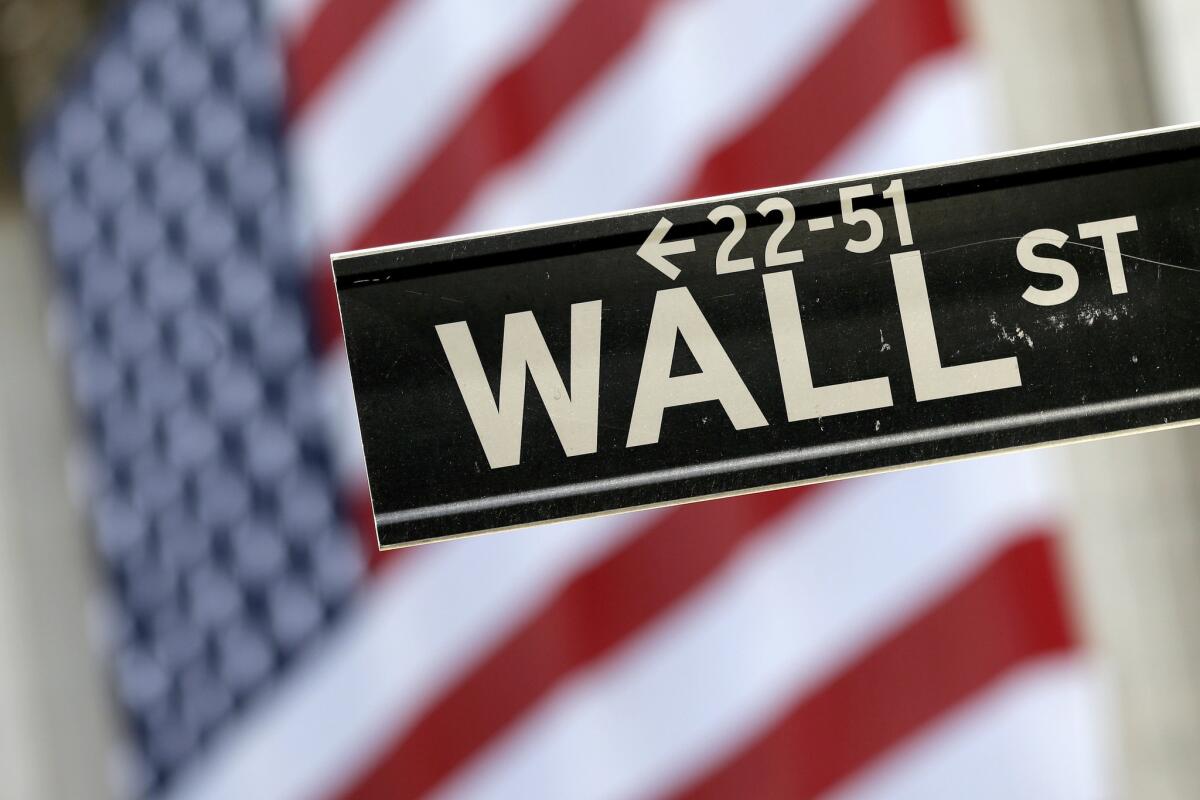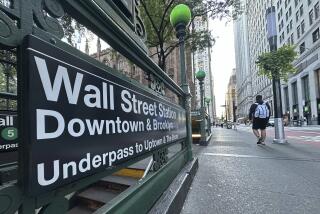Stocks sink on grim data about coronavirus’ economic effects

- Share via
Selling swept Wall Street on Wednesday after a dismal lineup of reports made clear how severe the coronavirus crunch has been for the economy.
Markets are already bracing for what’s forecast to be the worst downturn since the Great Depression, but Wednesday’s data were even more dispiriting than expected, including a record drop in U.S. retail sales. Adding to the gloom: More banks made moves in anticipation that households and companies will be forced to default on billions of dollars of debt as businesses remain shut and millions of workers lose their jobs.
Stocks around the world fell, reversing Tuesday’s up trend, as markets continue to cycle between fear and budding optimism about how long and deep the recession will be.
The Standard & Poor’s 500 index slid 62.70 points, or 2.2%, to 2,783.36. The Dow Jones industrial average fell 445.41 points, or 1.9%, to 23,504.35, and the Nasdaq declined 122.56 points, or 1.4%, to 8,393.18.
“We should take any company forecast and analyst forecast with a grain of salt here,” said David Kelly, chief global strategist at JPMorgan Funds. “There are many analysts who are just as bewildered as companies are.
“What you need to be here is an epidemiologist more than anything else.”
Stocks will probably remain volatile as long as investors are uncertain about how long the downturn caused by the coronavirus outbreak will last, and that ultimately depends on when health experts can corral the virus.
Wednesday’s economic lowlight was a report showing U.S. retail sales plummeted 8.7% last month, as the engine of the U.S. economy gets locked away amid widespread stay-at-home orders to slow the spread of the virus. Industrial production across the country also dropped in March by the largest percentage since 1946, and an April survey of manufacturers in New York state fell to its lowest reading on record. A measure of confidence among home builders hit its lowest level since 2012.
Treasury yields sank after the release of the reports, a sign of concern about growth in the economy. The yield on the 10-year Treasury fell to 0.63% from 0.75%.
The retail sales data hit markets particularly hard because consumer spending makes up about two-thirds of the U.S. economy. The data also led to questions about what a recovery will look like.
“How does this impact consumer behavior in an economy largely driven by consumers?” asked Keith Buchanan, portfolio manager at Globalt.
Energy stocks took the sharpest losses after oil prices touched another 18-year low. Those in the S&P 500 index fell 4.7%, including a 5.5% slide for ConocoPhillips and a 4.6% drop for Exxon Mobil.
Here’s an inside look with doctors and nurses on the frontlines of the COVID-19 battle.
Worldwide demand for oil will fall this year by a record amount amid widespread lockdowns, the International Energy Agency said Wednesday. Benchmark U.S. crude touched its lowest price since 2002 before recovering slightly to $19.87 a barrel, down 24 cents from a day earlier. Brent crude, fell $1.91, or 6.5%, to $27.69 a barrel.
Financial stocks were also among the market’s biggest losers after more banks said they had to set aside billions of dollars in preparation for a coming avalanche of defaults. Bank of America shares fell 6.5%, and Citigroup lost 5.6%.
Investors are focusing on how and when authorities may begin to ease business shutdowns and limits on people’s movements. The S&P 500 jumped 3.1% on Tuesday on hopes that the outbreak was leveling off in some hot spots, which could lead to parts of the economy opening back up.
That gain capped a rally that sent the S&P 500 up 27% from its March 23 low. The upswing started after the Federal Reserve and U.S. government announced massive aid to prop up the economy. The index is down about 18% from the all-time high it reached in February.
Although still jarring, the yo-yo moves of recent weeks have been less severe than earlier in the sell-off, when daily moves of 8% and even more than 10% racked markets.
”We’re past the indiscriminate selling period,” said Leo Kelly, chief executive of Verdence Capital Advisors. “The market is trying to discover what that looks like on the other side.”
President Trump has been discussing how to roll back federal social distancing recommendations. U.S. governors are collaborating on plans to reopen their economies in what is likely to be a gradual process to prevent the coronavirus from rebounding.
China has reopened factories, shops and other businesses after declaring victory over the outbreak, but forecasters say it will take months for industries to return to normal output, while exporters will face depressed global demand.
But if the market’s hopes for an upcoming reopening prove to be too optimistic, it probably sets stocks up for steep declines ahead.
“It’s correct now to be a little bit more hesitant,” said Liz Ann Sonders, chief investment strategist at Charles Schwab. “Did we go a little too far too fast?”
More to Read
Inside the business of entertainment
The Wide Shot brings you news, analysis and insights on everything from streaming wars to production — and what it all means for the future.
You may occasionally receive promotional content from the Los Angeles Times.










